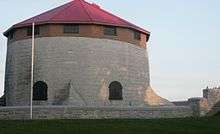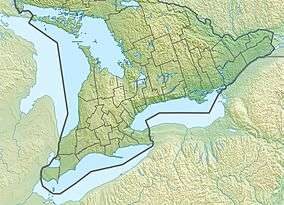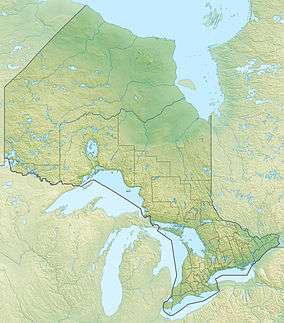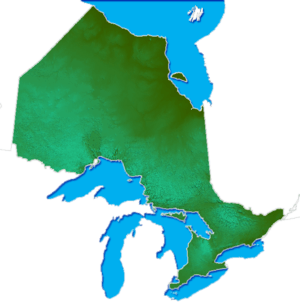Murney Tower
 | |
| Established | 1846 |
|---|---|
| Location | Murney Point, Kingston, Ontario, Canada |
| Type | Martello tower |
| Website |
www |
| Designated | 1930 |
| UNESCO World Heritage site | |
| Official name | Murney Tower, Kingston |
| Part of | Rideau Canal |
| Criteria | Cultural: (i)(iv) |
| Reference | 1221-006 |
| Inscription | 2007 (31st Session) |
| Area | 0.17 ha (18,000 sq ft) |
| Buffer zone | 2.71 ha (292,000 sq ft) |
| Coordinates | 44°13′20″N 76°29′25.5″W / 44.22222°N 76.490417°WCoordinates: 44°13′20″N 76°29′25.5″W / 44.22222°N 76.490417°W |
 Location of Murney Tower in Southern Ontario  Murney Tower (Ontario)  Murney Tower (Canada) | |
Murney Tower is a Martello tower in Kingston, Ontario, Canada, whose construction dates to January of 1846. The Tower was built in response to the Oregon Crisis, which was a tense dispute over the border between British North America and the United States in the 1840s. When the tower was first constructed they planned to call it Murray Tower after the Master General of Ordnance. The land however, was owned by the Murney family and was called Murney Point by the locals. They thus began calling the tower, Murney Tower. This name stuck. The original inscription stone above the door read ‘Murray Tower.’ An ‘N’ was affixed over the first ‘R’ so that the current sign reads ‘MURNAY TOWER’, a hybrid spelling of the two versions.
The Tower is one of five components of the Kingston Fortifications that defended Kingston Harbour, the Naval Dockyard, military supply depot and the southern entrance of the Rideau Canal. Murney Tower complements the fortifications of Fort Henry, Ontario, Cathcart Tower on Cedar Island, Shoal Tower in the Confederation Basin and Fort Frederick on the grounds of the Royal Military College of Canada. In addition to protecting the harbour and approaches to Kingston, these fortifications were designed to concentrate fire on Gardiners Island; it being the only place to effectively land artillery at the time.
The Tower stands surrounded by a dry-ditch and is accessible only by a bridge. Murney Tower is constructed of limestone with special brickwork on the barracks and basement levels of the Tower's interior. On the thickest side the walls are about 15 ft. thick at the base and 13ft. thick up top. On the weaker side the walls are about 8 ft. thick. The walls are thicker on the south side because a naval attack from the Americans was the most likely form of attack and thus is what the tower is prepared for. Cannonballs from enemy ships should just bounce right off the walls.
The Tower was occupied from 1848 until 1885. The main floor (ground level) was the barracks level where the soldiers and their families lived, ate, and slept. It was manned by the Royal Canadian Rifle Regiment until 1870, then by Battery A until 1880, and Battery B until 1884. After 1885 it was watched by the PWOR (Prince of Whales Own Rifles). It could house a maximum of 24 soldiers and one officer or multiple soldiers and their families. Currently, the barracks has two internal carronade cannons fired 32-lb cannonballs directed out shuttered windows. These cannons could be moved about the interior embrasures, and so cover multiple approaches, including the bridge. The lower floor contained the ventilated magazine and storage rooms, along with 4 capponieres, which acted as a defense system for the dry-ditch surrounding the Tower, allowing soldiers to fire through small loopholes at troops attacking the Towers base. The uppermost level is the artillery or gun platform, which supports a Blomefield cannon (which also fired 32-lb cannonballs) that could be rotated along an iron track, thus, providing full coverage around the Tower's entire circumference. Roofs are not original Mediterranean design of Martello towers, but a temporary snow roof was later added to the open gun platform two years after the Tower's construction protects the gun and keeps out the large amounts of snow. The addition of a roof is a common feature on Canadian Martellos. In 1921 a windstorm removed the original wooden roof, and the replacement roof does not allow for rapid removal as originally intended.
Despite being one of the most sophisticated Martello towers designed and built by the British, Murney Tower quickly became obsolete due to improvements made in military weaponry and ship design.
Presently, Murney Tower is a National Historic Site,[1][2] and is also part of the Rideau Canal and Kingston Fortifications World Heritage Site,[3] managed and maintained by the Kingston Historical Society, which operates it as a military museum during the summer months (Victoria Day Weekend in May — Labour Day in September). Displays include three cannons (32-pounder), period uniforms, muskets, and other mid-19th century military artifacts.
Although 14 Martello towers were built in Canada, only 9 are still standing, 4 of them in Kingston. Currently, only Murney Tower Museum is open to the public. Fort Henry has two towers that resemble Martello towers, however, they are branch ditch towers.
References
- ↑ Murney Tower, Directory of Federal Heritage Designations
- ↑ Murney Tower. Canadian Register of Historic Places.
- ↑ http://whc.unesco.org/en/list/1221
- Kingston Fortifications National Historic Site Management Plan, Parks Canada, 2006
- Parks Canada, Murney Tower National Historic Site: Defending Our Past brochure, undated.
- Lavell, W.S., A Story in Stone: Murney Redoubt, 1963, undated revision by Richard Arthur Preston, Kingston, Ontario.
External links
- Murney Tower - Kingston Historical Society
